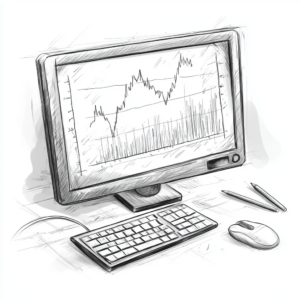Can the Crypto Industry Overcome Its Wash Trading Addiction?
October 21, 2024 (updated April 29, 2025)
Wash trading isn’t just a peripheral problem in crypto markets; it’s become the norm. This practice, where tokens are bought and sold by the same entity to create an illusion of market activity, has evolved from a niche tactic to a standard business model for many companies in the crypto space: tokens, market makers, and exchanges.
The Omnipresence of Wash Trading
The FBI’s October 2024 actions revealed the startling extent of this normalization. Companies involved take a fixed monthly fee for wash trading and a percentage cut of sold tokens during pumps. It’s essentially a profit-sharing model – quite fair in its construction, except for the investors being deceived.
Wash trading is visible on centralized exchanges (CEXs), with small order depth coupled with enormous, clearly inorganic volume. But it doesn’t stop there. It’s also prevalent on decentralized exchanges (DEXs) despite higher costs. Even on expensive platforms like Ethereum-based Uniswap, short-term wash trading operations attract retail investors hunting for ‘hot tokens’.
We should also consider artificially generating activity on L1 or L2 blockchains, a form of wash trading. Thousands of new addresses making artificial transfers can suddenly make a blockchain appear as a formidable Ethereum competitor, attracting eager investors.
Are Investors Without Fault?
What struck me was that when news broke about Gotbit’s and CLS’s accusations, prices of associated tokens like Neiro, Turbo, and Baby Doge Coin barely flinched. In traditional finance, such news would trigger an immediate price crash. Is crypto different? Yes, it is. It seems like investors knew it or didn’t care.
Many investors, particularly those with larger portfolios and lower risk appetites, left crypto after falling victim to manipulative practices. We have lost them and will never get them back. However, many of those who left adopted a predatory approach—”If you’re trying to outsmart me, I’ll outsmart you.” This has fostered a community of degens who wear their casino mindset as a badge of honor.
Many such investors are well aware of the game they’re playing. They’re not just aware of pumps; they’re attracted to them. They analyze past pump schemes, dissect social sentiment data, and track whale wallet movements, planning to jump off the ship before it crashes.
This segment of the crypto market is more interested in quick gains than long-term project value, creating an environment where wash trading and pump schemes are not just tolerated but expected.
The Normalization of Manipulation
We’ve become so accustomed to manipulation that we often fail to notice it. Take sandwich attacks on Ethereum transactions, for instance. In traditional finance, this would be called front-running. In crypto, we view it as a technological race for optimization.
Wash trading is merely a symptom of deeper problems plaguing the crypto ecosystem. Chief among these is the need for genuine adoption. Lacking that, we invent narratives. Despite years of development, many crypto projects still need practical applications beyond speculation. This creates an environment where projects, instead of focusing on a product, concentrate on their statistics to attract attention and investment.
When Playing by the Rules Backfires
Paradoxically, firms attempting to operate within regulatory boundaries often face significant challenges. The last news about Cumberland DRW, an established trading firm that bought a licensed broker to meet SEC requirements, shows that after four years, the SEC responded that this wasn’t sufficient, limiting Cumberland to trading only BTC and ETH. This illustrates the near-impossibility of regulatory compliance in the crypto world, even for willing firms.
Even projects with real value struggle in this environment. When all these meme coins with no substance or community backing attract investors, it’s tempting to conclude that only marketing matters – and wash trading is just part of the marketing toolkit. This mindset makes wash trading seem harmless to those who employ it.
However, it harms those who don’t engage in these practices. Many good projects grapple with ethical dilemmas when their weaker competitors attract more investors due to artificially inflated market statistics, making the game uneven.
Two Scenarios for the Future
Where do we go from here? The naive scenario could look like this:
- Accused firms scale down operations.
- Some tokens abandon these practices.
- The industry shifts towards transparency.
- Rouge market makers focus on building long-term investor trust through ethical practices.
But I must admit, this is wishful thinking. The idea that catching a few bad actors will suddenly heal the entire market is unrealistic.
There is another, more probable scenario, the polarization scenario:
- The market further divides into white and black hats, shady and regulated exchanges, legitimate tokens and scams, and honest and dishonest market makers. They will just choose different jurisdictions.
- Many tokens and exchanges continue to deliberately use manipulative techniques, which will become increasingly sophisticated.
- Investors, accustomed to this market image, remain largely unfazed by revelations of manipulations.
- Regulatory actions discourage compliance attempts, pushing more operators underground.
A few years ago, I would finish my reflection with positive statements like, ‘We must ask ourselves: what kind of crypto ecosystem do we want to build? One based on smoke and mirrors, or one built on real value and innovation?’
But now I see a more nuanced path forward. We need regulatory frameworks that reward compliance rather than punish innovation—friendly regulations for those who play by the rules. Yet this raises a thornier question: how do we address widespread fraud in a jurisdictionally fragmented world? Traditional enforcement mechanisms break down when operators can simply relocate to more permissive territories.
The answer might not lie primarily in regulatory overreach, but in investor consciousness. When investors begin treating wash trading and other manipulative practices as red flags rather than opportunities, the economic incentives for deception will diminish. This shift is already happening among more sophisticated participants, who recognize that projects relying on artificial metrics rarely deliver sustainable value.
Perhaps the most effective regulation will come from the bottom up—a market that increasingly demands transparency and authenticity, treating manipulation not as an expected part of the game but as a disqualifying factor. The polarization I described is real, but it also creates an opportunity for differentiation. As the distinction between legitimate and manipulative projects becomes clearer, those building on solid foundations may finally receive the premium they deserve.
Michal




